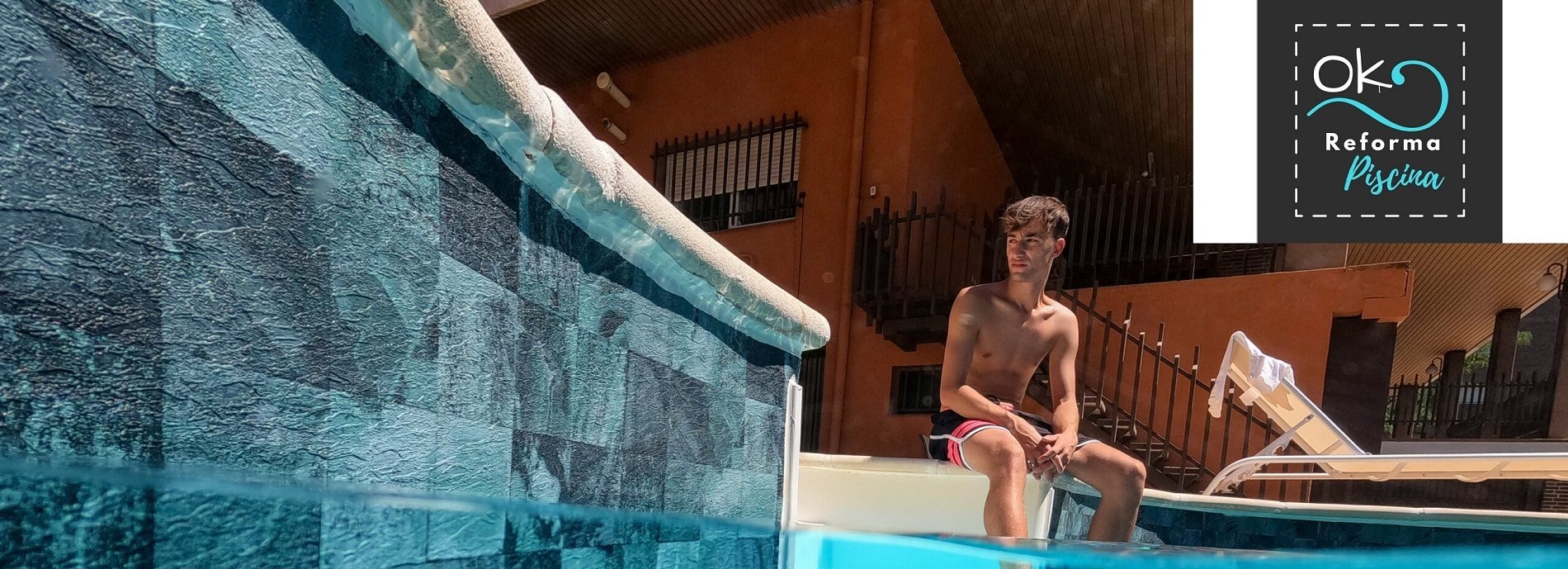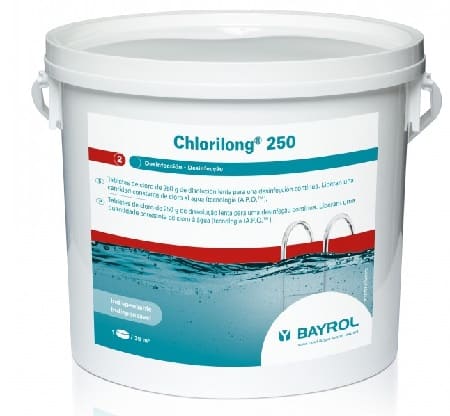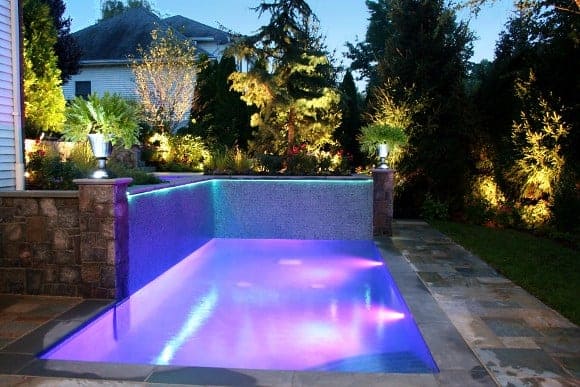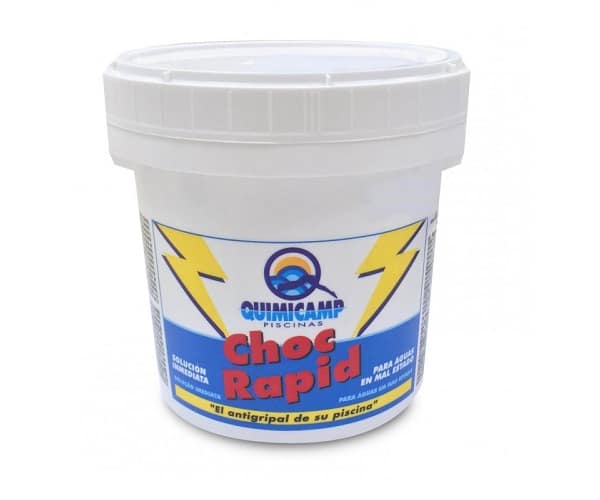
Table of contents of the page
En Ok Pool Reform within Chemical products We present the article about: How to use shock chlorine?
What is chlorine
Pool chlorine function
Chlorine is the product par excellence both for water treatment and for pool care. It is also the most used and known on the market for its price, ease and comfort of use.
There is a wide range and types of chlorinated products
Types of pool chlorine There is a wide range of chlorinated products for maintaining pool water that are distinguished by their composition, effects and formats.
There is dichlor, trichlor and calcium and sodium hypochlorite.
As for formats, there are different types of presentation depending on the type of chlorine application: chlorine tablets or tablets, granulated chlorine, powder chlorine and liquid chlorine.
What is a shock treatment in the pool
How to use shock chlorine
Pool shock treatment is the process of adding chemicals (usually chlorine) to your pool to: break down chloramines, also known as combined chlorine quickly increase your chlorine level kill algae, bacteria or other harmful pathogens
What is shock chlorine shock treatment?
Shock treatment with shock chlorine is the same as what we just described just now, with the uniqueness that the process is carried out with the specific chemical product called shock chlorine; regardless of the concept of whether shock chlorine is stabilized or not.
DO NOTTA: We are going to cover the concept of stabilized or unstabilized shock chlorine right on this page.
What is fast chlorine

What is shock chlorine?
Basically, shock chlorine, also known as rapid chlorine, is a pool chemical which restores optimal disinfection to your pool in a minimal amount of time.
Why is it called “shock” chlorine?
In granular form, it has a high chlorine content and high water solubility. It is the solubility of the product that gives it its name shock chlorine, or fast chlorine, since its action is much faster than that of slow chlorine where the dilution speed is lower.
What it is for and how to use shock chlorine
Shock chlorine, as its name suggests, is used as a shock treatment in the pool; That is, mainly, it is used when the pool needs intense disinfection in a short time.
When to use shock chlorine

When and how to use shock chlorine
Below, we leave you a list of the possible reasons why you should perform a shock treatment and then we explain why:
- When, why and how to use shock chlorine?
What types of pool shock CHLORINE treatment can we use?
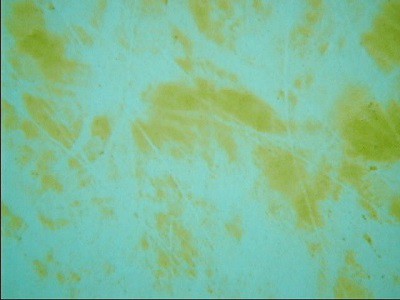
Two types of shock chlorine: Stabilized or NOT Stabilized
Type Stabilized pool chlorine = chlorine together with isocyanutic acid (CYA)
Stabilized chlorine is the collective name assigned to chlorine when a pool stabilizer has been added, or specifically, cyanuric acid, or its chlorinated compounds such as Sodium Dichloroisocyanurate and Trichloroisocyanuric Acid.
Cyanuric acid pool what is it
What is cyanuric acid in swimming pools?: Chlorinated isocyanurics are a weak acid stabilized chlorine compound (C3H3N3O3), with limited solubility in water (chemical additive) that is incorporated to stabilize chlorine in water. Furthermore, although it is essential for the maintenance of the pool, it is actually little known among owners of private pools and is even rarely mentioned in pool specialist stores despite its vital importance.
NON-stabilized chlorine
What is unstabilized chlorine?
Unstabilized chlorine is chlorine to which cyanuric acid (a pool stabilizer) has not been added.
Of course, it is much more unstable, it must be handled with care because it does not contain a stabilizer, so it is much more sensitive to the effects of the sun.
Comparative table of stabilized and non-stabilized shock treatment
Next, we show you a comparative table with the different types of chlorine, or chlorine compounds most used in pool water sanitation.
| Number of Types of chlorine for swimming pools | Stabilized or not (contains or does not contain CYA = isocyanuric acid) | Chemical composition of types of chlorine for swimming pools | Chlorine volume in the Types of chlorine for swimming pools | Effect of Types of Pool Chlorine on pH: | Appropriate treatments of chlorine types for swimming pools | Description of use of types of chlorine for swimming pools |
|---|---|---|---|---|---|---|
SHOCK CHLORINE OOther names for pool shock chlorine: *Also known as dichloro pool, fast chlorine or shock chlorine, sodium cycloroisocyanurate and dichloro-S-triazinetrione. | Chlorine is quickly stabilized Stabilizer content (isocyanuric acid): 50-60%. | . | Available chlorine by volume: 56-65% | Effect on the pH of shock chlorine: Product with neutral pH: 6.8-7.0, so it has no effect on the pH of the pool water, nor does it raise or lower the pH. | Indicated use Dichloro pool: SHOCK treatment of pool water | Shock Chlorine Used for pool starter treatment Likewise, It is used for rebellious cases as green waters or lack of chlorination- |
| CALCIUM HYPOCHLORITE OOther names for Calcium Hypochlorite: *Also know as (Cal Hypo) Chlorine tablets or granulated chlorine | Stabilizer content (isocyanuric acid): IT DOES NOT HAVE. Prevents overstabilization of the pool with cyanuric acid. | | Available chlorine by volume: Generally Calcium hypochlorite is sold with a purity of 65% to 75% chlorine concentration, mixed with other chemicals present, such as calcium chloride and calcium carbonate, resulting from the manufacturing process | Effect on pH: The pH of this type of product is very high, that is, strongly alkaline: 11.8 – 12.0 (it will require exhaustive control in case we need to lower the pH of the pool water ) | Intended use Pool Calcium Hypochlorite: SHOCK treatment of pool water | Calcium hypochlorite acts as an effective and immediate shock treatment disinfectant agent; eliminate impurities from water with fungicide, bactericide and microbicide action. Yes |
Shock treatment for pools with NON-stabilized chlorine
Calcium hypochlorite

Names given to calcium hypochlorite chlorine
Calcium hypochlorite can be called by the following names: Cal-Hypo, chlorine tablets or granulated chlorine.
Most used powder pool maintenance disinfectant calcium hypochlorite
Properties as a disinfectant, fungicide, bactericide and microbicide agent
Calcium hypochlorite is the most popular disinfectant among private pool owners; and can be supplied in powder or tablet form.
Calcium hypochlorite characteristics
- To begin with, calcium hypochlorite is white, solid, and can be purchased in tablet or granular form.
- This product is easy to store and apply, and destroys a wide variety of pathogens, although due to its slow dissolution it can clog pool components, cloud the water, reduce pH and increase alkalinity.
- Generally Calcium hypochlorite is sold with a purity of 65% to 75% chlorine concentration, mixed with other chemicals present, such as calcium chloride and calcium carbonate, resulting from the manufacturing process.
- Byproducts in pool water: hypochlorous acid (HOCl) + calcium (Ca+) + hydroxide (OH-)
- Finally, the pH of this type of product is very high, that is, strongly alkaline: 11.8 – 12.0 (it will require exhaustive control in case we need to lower the pH of the pool water )
Advantages Calcium Hypochlorite
- Water and energy consumption can be reduced
- Minimizes the need for pH corrections
- Helps protect the plant from corrosion
- Does not increase cyanuric acid levels
- Improves water quality and bather comfort
- It is easier to achieve balanced water
- Helps control total dissolved solids
- Particularly for pools with plaster surfaces, hypo lime helps saturate the water with calcium to reduce the risk of etching.
Warning when using chlorine tablets or granules
Always wear gloves and protective equipment when handling tablet or granular chlorine, and keep it stored away. safe way.
It is a very strong oxidizer and a fire hazard, and when close to certain chemicals (other types of chlorine, for example), it can spontaneously burn. Never, and we repeat, never put any other type of chlorine in a lime hypofeeder.
Cons chlorine tablets or granules
- The main thing to keep in mind is that lime-hiccup will increase the calcium hardness levels in the water. If pool water remains too hard for too long, it can cause corrosion to the pool surface. Next, we leave you a page where we explain how to lower the hardness of water.
- Cal-hypo also has a high pH of approximately 12, therefore it will be necessary to monitor that the pH of the pool has not increased.
Buy Calcium Hypochlorite
calcium hypochlorite price
Metacril HypoChlor Tab of 5 kg of calcium hypochlorite 65% in 7 g tablets for swimming pools
[amazon box= «B07L3XYWJV » button_text=»Buy» ]
Granulated Calcium Hypochlorite with Approx. 70% Active Chlorine
[amazon box= «B01LB0SXFQ » button_text=»Buy» ]
Granulated Calcium Hypochlorite powder
[amazon box= «B07PRXT9G2 » button_text=»Buy» ]
Pool shock treatment with Stabilized chlorine
Shock chlorine

Names given to shock chlorine
Shock chlorine can be given the following names: fast chlorine, dichloro pool, sodium dichloroisocyanurate and dichloro-S-triazinetrione.
What is pool dichloro for? quick chlorine or shock chlorine
When to perform a pool shock treatment
Firstly, mention thatPool dichloro is also known as rapid or shock chlorine, Quick chlorine is used for pool starter treatment and for stubborn cases as green waters or lack of chlorination; That is, what is sought is to achieve the optimal chlorine level in a short time.
Situations in which to perform a pool shock treatment
- Commonly used to superchlorinate water when the presence of chloramines (also known as combined chlorine) is detected. The product is available in granular or powder form.
- Kill algae, bacteria or other harmful pathogens
- If there has been a major storm, or any other cause that may require immediate disinfection.
- At the beginning of the swimming season if you have had the pool overwintered.
- etc.
Chemical composition of pool shock treatment
- First of all, the fast chlorine type byproducts in the pool water: sodium cyanurate (NaH2C3N3O3) + hypochlorous acid (2HOCl)
- Available chlorine by volume: 56-65%
- In addition, it contains a stabilizer (Isocyanuric Acid) that slows down the evaporation of the product in the sun's rays: approximately 50-60% is isocyanuric acid.
- pH: 6.8-7.0 (neutral) which means only a small amount of pH increaser.
Advantages of shock chlorine
Quick chlorine disinfection efficiency immediately
Rapid chlorine is the solution for rapid and intense disinfection of pool water in a short time so that it dissolves in the water almost instantly thanks to its active ingredient.
Disadvantages of fast chlorine
Cons shock chlorine
- a small amount of pH increaser with the use of dichlor
- .this type slightly reduces the total alkalinity of your pool water.
- Dichlorine is a fire hazard and is not easily introduced through an automatic feeding system due to its fast-dissolving nature.
Buy shock chlorine
granulated rapid chlorine
Chlorine Shock Treatment 5kg
[amazon box= «B0046BI4DY » button_text=»Buy» ]
Dichlorine granules 55%
[amazon box= «B01ATNNCAM» button_text=»Buy» ]
Shock granulated chlorine for fast action 5 kg
[amazon box= «B08BLS5J91″ button_text=»Buy» ]
Gre 76004 – Granulated shock chlorine, shock action, 5 kg
[amazon box= «B01CGKAYQQ» button_text=»Buy» ]
Estimated amount of chlorine shock dose

Chlorine shock dose: it will depend on the volume of the pool water (m3)
How to calculate pool water
First, to know the chlorine shock dose you will need to know the amount of water in your pool.

Calculate pool water: length x width x average height of the pool
How much shock should I generally use if the pool water looks blue and clear?
Generally speaking, the amount of shock dose for pool maintenance when the water appears blue and clear is approximately 20 g per m3 (tablets or powders).
Chlorine shock granules dosage
How much pool shock chlorine to use in case of cloudy or green water?
If the water is cloudy or cloudy add 30-50 g of shock chlorine per m3 of water; always depending on the extent of the algae bloom. .
How much pool shock chlorine to use? VERY cloudy or VERY green water
If your water is very cloudy or very green, a tripled treatment dose is not unusual (sometimes it is even multiplied by 6).
The higher the level of solids, algae or chloramines found in the water, the more shock in the pool will be needed to oxidize the matter.
Visibility (or lack thereof) is another way to measure the severity of an algal bloom.
A example mode. If you can see the floor at the end of the pool at the shallowest spot, you should use a double dose of shock.
Shock dose of chlorine for the elimination of chloramines
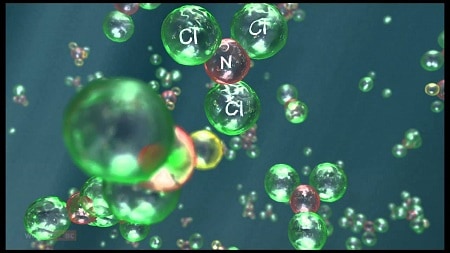
What are chloramines
- Free chlorine becomes combined chlorine when it binds to nitrogen or ammonia.
- The bond renders the chlorine molecule useless and makes pool water smell strongly of chlorine and irritates swimmers' eyes.
What to do when I have an excess level of chloramine
When chloramine levels exceed 0.5 ppm (TC-FC = CC), add enough chlorine or shock without chlorine to break up the combined chlorine, typically 10-20 times the tested CC level.
Tips and safety on how to use shock chlorine
Cost Saving Tip
- Asave on chemical costs by adding chlorine for shock treatment after dark; During the day, something will be lost in sunlight.
- Don't buy more pool chemicals than you will use in one season; They lose effectiveness over time.
How to safely handle fast-acting chlorine
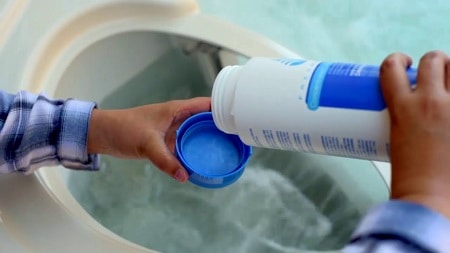
- Never store shock bags open, which can leak.
- Use the entire bag at once.
- Carefully cut the bag with scissors and pour it into the water while walking along the edge of the pool. Use a pool brush to distribute and sweep or wash any spills into the pool.
- Vinyl liner pools must have granular shock pre-dissolved unless quick dissolving Oxy Shock is used.
- Never mix shock bleach with anything other than water.
- Pool shock is very reactive and when mixed with any substance other than water, it can release toxic gases, catch fire or explode.
- Never place a shock in a chlorinator or float, or add it to the skimmer, always add directly to the pool.
Warnings on how to apply shock chlorine
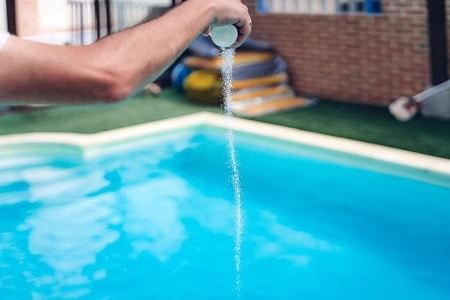
Preventions in the application of shock chlorine
- Balance the pH between 7,2 and 7,4 before applying the shock for the most powerful effect.
- Remember that a low pH level is crucial to successfully impacting a pool. At a pH level of 8.0, more than half of your discharge is ineffective and wasted. However, at a pH level of 7.2, over 90% of your shock will be converted to active algae and bacteria killers.
- Add Pool Shock separately, it may destroy or disrupt other treatment chemicals.
- Never allow the pool shock to become hot, humid, or contaminated with dirt or debris.
- Never allow pool shock to mix with any other pool chemicals, even the same type.
- Never pour pool buffer into skimmer, pre-dissolve for use in vinyl liner pools.
- When transmitting a shock through the surface, take into account the wind direction.
- Brush the pool after flushing and filter the water for at least 8 hours afterwards.
- If the chlorine level is zero within 8 hours of flushing the pool, re-flush the pool with a stronger flush.
- Hit your pool after the sun goes down, to reduce the effects of UV rays degradation.
- Sometimes you miss the mark when trying to clear adverse water conditions. If you still have a high chlorine level 12 hours after flushing and the appearance of the water improves with filtering, mission accomplished (probably). But, if the chlorine level returns to zero after 12 hours and the pool doesn't look much better, you may have missed the mark or threshold outside of the chlorination breakpoint. Try again.
How to apply shock chlorine

Granular shock chlorine treatment
- First, we must clean the pool to remove existing leaves and debris.
- In second place, we check the pH level and adjust it to 7,2 (especially for the effect to appear we need the pH not to be high, we indicate a link to know how to lower the pH of the pool).
- We determine the amount of shock chlorine to solve the situation.
- ATTENTION VINYL / LINER POOLS: Dilution in a bucket is necessary to dissolve the granules and prevent damage to pool surfaces.
- Always read and follow the manufacturer's instructions.
- Never mix different types of bleach; add each to the pool separately.
- Never mix chemicals, add each to the pool separately.
- Then, we add shock chlorine when we know that the sun is not going to impact the pool anymore.
- So, we distribute the shock chlorine over the entire surface of the pool, with the pool pump running.
- Avoid breathing fumes or vapors.
- Be careful not to spill anything on your clothes or on the pool deck, and don't blow it into the wind!
- Brush the pool, this helps distribute the chemical and removes the layer of dust and film on the pool surfaces, which may allow some contaminants to escape the treatment.
- Next, if preferred, leave the filter in operation for 24 hours or at least during a filtering cycle of all the pool water (normally dependent on the pump and the type of pool you have, this is equivalent to about 6 hours.
- Then, check the pool values again.
- Finally, if necessary, repeat the process; although, if you see that you must repeat the method more than two times, we advise you to contact a professional):
Video tutorial How to use shock chlorine correctly
How to use shock liner chlorine
Liner pools: How to use shock chlorine properly
Possible problems when performing shock chlorination in a liner pool
For vinyl liner pools, undissolved granules resting directly on the vinyl can bleach, fade or corrode soft vinyl surfaces.
Product dissolution is the key to shock chlorination in a liner pool
Procedure to apply shock chlorination in a liner pool
- Pre-dissolution is achieved by filling a clean 5 liter bucket full of pool water.
- As additional information, you always add the chemicals to the water, not the water to the chemicals.
- You should then stir with a stick or suitable paddle for several minutes to dissolve the granules.
- Prevent chemicals (used for pool treatment) from having direct contact with the liner.
- To do this, dissolve them first in a container with water to reduce their concentration and distribute it later and evenly throughout the pool.
- Now you will need to pour 1 or 2 liters of the shock chlorine solution directly into the water, around the edge of the pool.
- To conclude, when the bucket is almost empty, stop, add more water to dissolve the remaining granules at the bottom of the bucket.
Pool Shock Chlorine Storage

Good storage of pool shock chlorine
- Store chemicals in a cool, dry, shaded place.
- Keep it in a separate location from other pool chemicals.
- Keep it out of the reach of children.
- Pool shock chlorine is stored most safely if it is removed from the cardboard box and placed inside a clean bucket or storage container with a tight-fitting lid.
- Do not store half-used shock bags, which could leak, become contaminated, or absorb moisture.
- Never store shock bags open, which can leak.
- Use the entire bag at once.
- For longer and safer storage, we recommend purchasing Cal Hypo loose in buckets or unchlorinated shock. Store in a dark, cool place, with a tight-fitting lid to prevent moisture and contamination and to prevent off-gassing.
Chlorine Shock Lifespan
How long does pool shock chlorine last?
The unopened product can last up to 4-5 years. The expiration date is on the back of the packaging.
Loss of effectiveness with storage
Granular bleach products will lose only a small percentage of potency when stored in a cool, dry, dark place.
However, when stored in a shed or garage, varying levels of temperature and humidity will begin to solidify the contents and, within a few years, the plastic bags will deteriorate.
